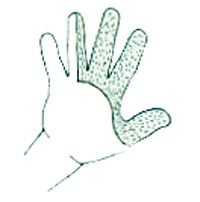Phalen's test: The patient rests the elbows on a flat surface, holds the forearms vertically, and actively places the wrists in complete and forced flexion for at least one minute. This maneuver moderately increases the pressure in the carpal tunnel and has the effect of pinching the median nerve between the proximal edge of the transverse carpal ligament and the anterior border of the distal end of the radius.1-3
Reverse Phalen's test: This test is performed by having the patient maintain full wrist and finger extension for two minutes. The reverse Phalen's test significantly increases pressure in the carpal tunnel within 10 seconds of the change in wrist posture and the carpal tunnel pressure has the tendency to increase throughout the test's duration. In contrast, the change in carpal tunnel pressure noted in the standard Phalen's test is modest and plateaus after 20 to 30 seconds. In a study comparing the changes in tunnel pressure with the Phalen's and reverse Phalen's test it was noted that the average pressure change for Phalen's test at one and two minutes was only 4 mm Hg. The average pressure changes in the carpal tunnel for the reverse Phalen's test were 34 mm Hg at one minute into the test and 42 mm Hg at the two minute point.4 Thus, the extended wrist posture significantly changes the pressure within the carpal tunnel and may be more useful as a provocative examination maneuver. In another study cited by Sunderland, flexion raised carpal tunnel pressure by 100 mm of water while extension raised the pressure in the tunnel to 300 mm.5
Tethered median nerve stress test: This test may be useful in detecting chronic, low grade median nerve compression in the carpal tunnel and may be most useful when sensory complaints predominate and motor signs are minimal. To perform the test, the doctor grasps the distal phalanx of the patient's index finger and pulls the index finger into forced extension and holds that position. This maneuver produces the greatest amount of median nerve distal excursion in the tunnel and combines the effects generated by the reverse Phalen's test with those of tractioning of the median nerve. The median nerve is bound, in some patients, to the tendon of the flexor digitorum profundus muscle to the index finger. Thus, by extending the index finger from the distal phalanx, the median nerve may be tractioned distally due to connective tissue attachments between the tendon and the nerve. The test produces discomfort as its most common provocative complaint which is characterized as aching and myalgic and increases the longer the test position is held. There may also be proximal radiation of pain from the carpal tunnel to the pronator teres muscle which may persist post-test.6
Direct pressure over the tunnel: Pressure of the examiner's thumbs applied directly versus the median nerve running deep to the transverse carpal ligament may produce pain, tingling, or numbness in the median nerve's field in the hand related to the carpal tunnel (Figure I). This test is specific for the carpal tunnel syndrome and has elicited symptoms in 87 percent of a bona fide group of carpal tunnel syndrome patients. The average time to the onset of symptoms with direct compression of the median nerve is between 16 seconds and 29 seconds. In contrast, the standard Phalen's test elicited symptoms in approximately 70 percent of patients with the average onset of symptoms taking approximately 25 seconds following the initiation of the flexed hand position.
Tinel's sign: Light percussion over the median nerve as it passes under the transverse carpal ligament may elicit a shock-like sensation which radiates into the median field of the hand. Percussion should begin distally and progress proximally. For future comparison, a measurement should be made from a bony prominence to the point of maximum response once that site has been identified. This test is the least sensitive of the median nerve provocative maneuvers but is the most specific test for median neuropathy at the carpal tunnel.5,7
Tourniquet test: A blood pressure cuff is applied proximal to the elbow and cuff pressure is taken beyond systolic pressure.5,7 The pressure induced ischemia in the distal limb may cause damaged nerve fibers to react to the ischemia by discharging spontaneously, aggravating the condition. The test is considered to be positive if symptoms occur within one minute, however the test does have an abnormally high false positive rate (upwards of 40 percent).
References
- Phalen GS, Gardner WJ, and La Londe A. Neuropathy of the median nerve due to compression beneath the transverse carpal ligament. JBJS, 32A:109-112, 1950.
- Phalen GS and Kendrick JI. Compression neuropathy of the median nerve in the carpal tunnel. JAMA, 164:524-530, 1957.
- Phalen GS. The carpal tunnel syndrome. JBJS, 48A:211-228, 1966.
- Werner RA, Bir C, and Armstrong TJ. Reverse Phalen's maneuver as an aid in diagnosing carpal tunnel syndrome. Arch Phys Med Rehabil, 75:783-786, 1994.
- Sunderland S. Nerves and Nerve Injuries.
Churchill-Livingstone, New York, 1978. - LaBan MM, MacKenzie JR, and Zemenick, GA. Anatomic observations in carpal tunnel syndrome as they relate to the tethered median nerve stress test. Arch Phys Med Rehabil, 70:44-46, 1989.
- Gellman H et al. Carpal tunnel syndrome: An evaluation of the provocative diagnostic tests. JBJS, 68A:735-737, 1986.
Brad McKechnie, DC, DACAN
Pasadena, Texas





